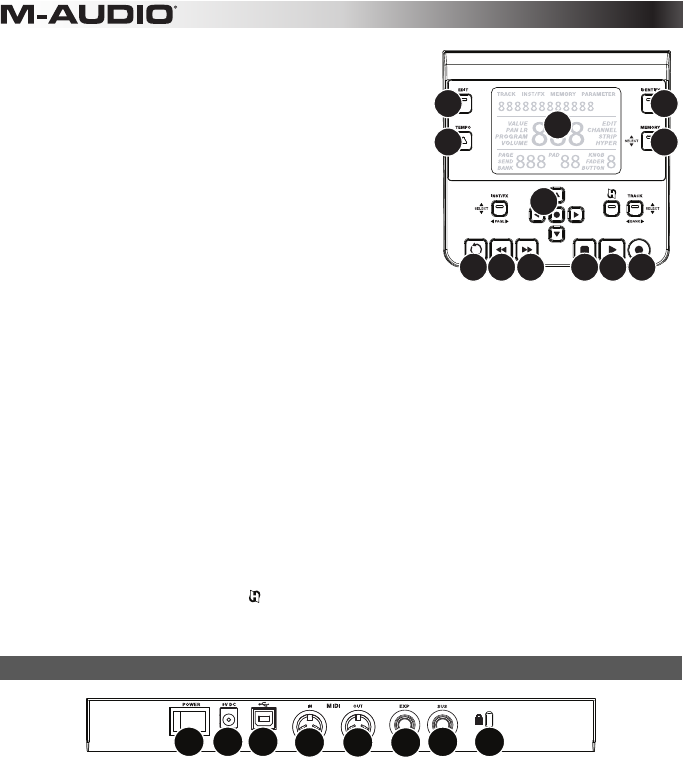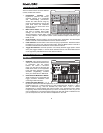
6
8. Main Control Panel:
A. LCD: This screen displays useful information, such as
the current assignment and setting of the most
recently moved physical control.
B. Edit Button: This button puts Axiom AIR in Edit Mode,
allowing you to use its keyboard's special functions to
create or edit MIDI control assignments, global
settings, and utility functions.
C. Tempo Button: This button flashes in time with the
tempo setting of the trigger pad roll function. Tap this
button at 1/4-note intervals to set the tempo. Press
and hold this button for over two seconds to set the
tempo manually, using Knob 8 or the up and down
Directional buttons. Press the center Directional button
to save the setting.
Note: When Axiom AIR receives incoming MIDI timecode (MTC) messages, it will automatically
synchronize with the external MIDI clock. These messages can be received only over Axiom
AIR's USB port.
D. Identify Button: Hold down this button and move a control to identify its assignment, which will
appear in the LCD. This lets you identify what is assigned to that control without actually sending
out any MIDI data. This is useful for reminding yourself of your assignments without changing
your settings, disrupting your live performance, etc. You can double-press this button to "latch" it
so it stays on. Press it once again to unlatch it.
E. Memory Button: This button lets you save and access Memory Locations for storing full MIDI
configurations. See the Memory Locations section of this manual for more information.
F. Transport Controls: These buttons control standard transport functions in DAW software: loop,
rewind, fast-forward, stop, play, and record. When a HyperControl-enabled DAW is running,
these buttons automatically map to those functions (or their closest alternatives). You can also
map these buttons to a variety of MIDI messages.
G. Directional Buttons: You can use these buttons for various navigational and parameter-setting
functions, depending on the setting of the adjacent Mode buttons.
• Inst/FX Mode (INST/FX button): The buttons will select the track and plug-in you want to
control with the faders and knobs.
• HyperControl Mode (
button): The buttons will have alternate, DAW-specific uses.
• Track Select/Bank Mode (Track button): The buttons will select the desired track or bank
of tracks to control in HyperControl Mode.
Rear Panel
1
23
45
6
7
8
1. Power Switch: Use this switch to power Axiom AIR on or off.
2. Power Input: Connect an optional power adapter here (9V DC, 3A, center-pin positive, sold
separately). Alternatively, you can power Axiom AIR via the USB port of your connected computer.
3. USB Port: When Axiom AIR is connected to a computer via USB, this USB connection powers Axiom
AIR and transmits MIDI data to and from the computer.
4. MIDI Input: Use a standard 5-pin MIDI cable to connect this input to the MIDI output of an external
MIDI device.
5. MIDI Output: Use a standard 5-pin MIDI cable to connect this output to the MIDI input of an external
MIDI device, allowing you to play the sounds in a MIDI sound module or a rack synth, for example.
6. Expression Pedal Input: Connect either a "switch"-type or standard expression pedal (sold
separately) to this input to allow for expressive changes while performing. This input is assignable to
different functions.
7. Sustain Pedal Input: Connect a momentary-contact sustain pedal (sold separately) to this input to
allow you to sustain the currently playing notes without having to hold the keys down. This input is
assignable to different functions.
Note: When you power on Axiom AIR, verify that your sustain pedal has the right "polarity" – that it
sustains notes when pressed down. If your sustain pedal is working "in reverse," remove your foot from
it, and power your Axiom AIR off then on again. (When powering on your Axiom AIR, it scans the
sustain pedal as being in the raised/off position.)
8. Kensington® Security Slot: This connector is compatible with standard laptop-style Kensington
security cables for theft protection.
A
B
C
D
E
FFF
G
FFF


















